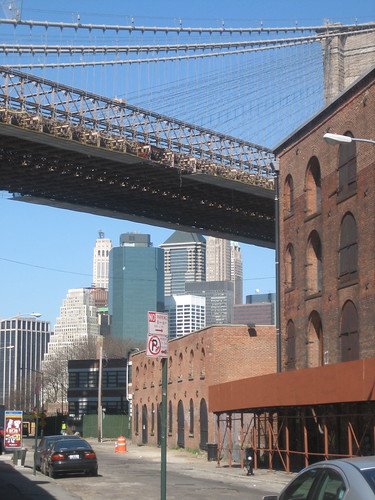Changing New York: Photographs by Berenice Abbott, 1935-1938
From the NYPL Digitial Collection
The Brooklyn Bridge as seen by Berenice Abbott in 1936.

The Brooklyn Bridge photographed from Water Street in 2008
"Photographer Berenice Abbott proposed Changing New York, her grand project to document New York City, to the Federal Art Project (FAP) in 1935. The FAP was a Depression-era government program for unemployed artists and workers in related fields such as advertising, graphic design, illustration, photofinishing, and publishing. A changing staff of more than a dozen participated as darkroom printers, field assistants, researchers and clerks on this and other photographic efforts. Abbott's efforts resulted in a book in 1939, in advance of the World's Fair in Flushing Meadow NY, with 97 illustrations and text by Abbott's fellow WPA employee (and life companion), art critic Elizabeth McCausland (1899-1965). At the project's conclusion, the FAP distributed complete sets of Abbott's final 302 images to high schools, libraries and other public institutions in the metropolitan area, plus the State Library in Albany.
Abbott was born and raised in Ohio where she endured an erratic family life. In 1918, after two semesters at Ohio State University, she left to join friends associated with the Provincetown Players, in Greenwich Village. There she met Djuna Barnes, Kenneth Burke, Elsa von Freytag-Loringhoven, Edna St. Vincent Millay, Little Review editors Margaret Anderson and Jane Heap, and other influential modernists. From 1919-1921, while studying sculpture, Abbott supported herself as an artist's model, posing for photographers Nikolas Muray and Man Ray. She also met Marcel Duchamp, and participated in Dadaist publications.
Abbott moved to Paris in 1921, where she continued to study sculpture (and in Berlin), and to support herself by modeling. During 1923-1926, she worked as Man Ray's darkroom assistant (he had also relocated to Paris) and tried portrait photography at his suggestion. Abbott's first solo exhibition, in 1926, launched her career. In 1928 she rescued and began to promote Eugène Atget's photographic work, calling his thirty years of Parisian streetscapes and related studies "realism unadorned. "
In 1929 Abbott took a new artistic direction to tackle the scope (if not the scale) of Atget's achievement in New York City. During 1929-38, she photographed urban material culture and the built environment of New York, documenting the old before it was torn down and recording new construction. From 1934-58, she also taught photography at the New School. During 1935-39, Abbott worked as a "supervisor" for the Federal Art Project to create Changing New York (her free-lance work and New School teaching commitment made her ineligible for unemployment relief) .
1970 saw Abbott's first major retrospective exhibition, at the Museum of Modern Art. Her first retrospective portfolio appeared in 1976, and she received the International Center of Photography's Lifetime Achievement Award in 1989. She died at home in Monson, Maine in December 1991."
Quoted from The NYPL Digital Gallery
For a non bridge specific view of Abbott's work, see both the original, Berenice Abbott: Changing New York and Douglas Lefevre's New York Changing: Revisiting Berenice Abbott's New York
There are 2,027 bridges in NYC.
I'm trying find all of them.
And then cross all of them.
Tuesday, April 15, 2008
Berenice Abbott
Posted by
bikebrooklyn
at
6:05 PM Permalink
![]()
Labels: Berenice Abbott, Brooklyn Bridge, historical, pop culture
Subscribe to:
Post Comments (Atom)

No comments:
Post a Comment